|
|
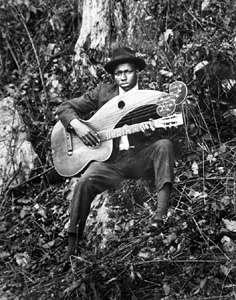
Todd
Jones, c.1921
(Courtesy of Perlista
Henry)
|
We
begin with one of the most iconic images of a black harp guitar
player known – striking not just visually, and not just
because we can easily identify the instrument as a Dyer Style 7,
but remarkable in
that we have long known the fellow’s name.
The
image came first – an old glass negative, found at a swap meet
in the 1970’s by a fellow named Mark Austin.
Many years later, the image was used either on the cover
of the newsletter of the Music Maker Relief Foundation or in a
2002 MMRF ad in the Oxford American
magazine.
I first came across it some ten years ago on the cover of an
unrelated CD of Blues music.
I subsequently found it on the web site of the Music
Maker Relief Foundation, but only as a small thumbnail, as they
were then offering prints of it (I didn't order one at the time,
they were not inexpensive). It was their
page (modified, but still here)
which explained that an African-American photographer who
documented black life in their small town took the photograph.
It also told how a descendant of the unknown harp
guitarist spotted the photo and recognized her grandfather, a
hotel waiter named Todd Jones.
Meanwhile, harp guitarist Stephen Bennett came across a
newspaper article about the photograph, which he subsequently
shared with me (and which I cannot now put my hands on).
I remember something about the attributed date being in
question (error). |
|
Jump
to January, 2006, when Todd Jones’ granddaughter, Perlista
Henry, wrote me asking what I knew of the photo (I had the
thumbnail duplicated on my website).
She was helping with a new book by Philip Hirsh, called Voices
from the Hollow: What happened when the Blue Bloods met the Blue
Ridge
(2006).
In it, Hirsh tells stories of his life in Bath County,
Virginia, where he – a white child of “privilege” – was
largely raised by his grandparents’ black maids and servants,
especially Alice Fortune, who
happened to be the first wife of Todd Jones.
As
the couple was divorced during the ‘twenties – long before
the author was born – there is virtually nothing in the book
about Jones’ musical life, beyond the famous photo.
As for the rather fancy Dyer Style 7 harp guitar, which
he may or may not have owned, the trail is also cold.
However, the book is worth reading, if only to get a
sense of the area and the (mostly later) times, including the
Homestead Hotel in Hot Springs where Todd Jones worked (more on
this below), and the abundance of black musicians in the
surrounding area.
What
scant information we do have comes from the short Music Maker
article, as relayed by Perlista Henry: |

|
|
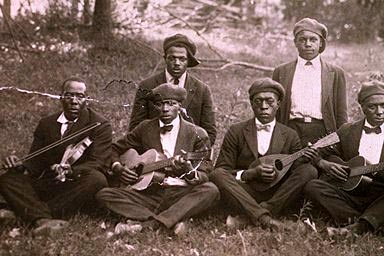
(Courtesy
of Perlista Henry) |
"Todd
Jones (my maternal grandfather) was born in 1897 in Warm Springs,
Virginia. He was the sixth of eleven children born to Albert
Sidney Jones and Eliza Brooks. Todd inherited his musical ability
from his mother's side of the family. He and his brother, Bernard
and older sister Beulah all played instruments. In 1918, Todd
married Alice Bolden (Fortune)(1899-1997), who also lived in Warm
Springs. He served in the armed services during World War I. The
couple had three children. Todd worked as a waiter at the
Homestead Hotel at Hot Springs. He also played with a local music
group, which included his brother, Bernard and other men from his
community.
Todd
and Alice were divorced during the 1920's. Todd relocated to
Washington, D.C., where he married and lived there until his death
on July 13th, 1956. He is buried at Arlington National
Cemetery." |
|
Perlista
Henry kindly supplied this additional photo (at left), saying: “The
names of the musicians are: Front row, left to right: Melvin Church with
violin, Todd Jones with guitar, James Pullins with mandolin, Bernard Jones
(Todd's younger brother) with guitar. Back row: Mozelle Pettus and his
brother Fred.”
|
|
Sometime after the above was written and published, a gentleman named
Larry Black contacted me about some new images. It seems
that he had acquired some glass negatives some forty years ago in the mid-1970's from a
co-worker who had brought them back from a flea market in
Winston-Salem, NC. It wasn't until last year, however,
that Larry finally had prints made –
in order to show them to the experts at the Antiques Roadshow.
Luckily for us, Larry passed on the Roadshow appraisers’ offer
of consignment (they thought it was Robert Johnson in the photo)
and subsequently donated beautiful scans of all the images to
Harpguitars.net.
Shortly after his Roadshow visit, Larry learned of the
very article you are reading and the well-known image of Todd
Jones above. Larry’s first email to me (sans image) was
quite curious: "The photo I have is identical right down
to the light colored, bent, upside down v-shaped piece of grass
by Todd's right foot. That piece of grass or straw is by the
foot of my gentleman, also. But it is definitely a different
man, and I think it was taken on the same day."! |
|
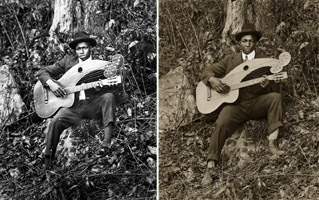
One Dyer harp guitar, two
brothers:
Todd (left) and Bernard (right) Jones, c.1921
|
Amazingly, Larry was right. It wasn't
Todd, but Todd's brother Bernard – posing in the exact
same spot with the same Dyer Style 7 harp guitar. All
of the vegetation in the shot (including that telltale piece of
bent straw) indicates that the photos were surely taken one
right after another.
His identity was deduced from comparison to the photo of the
group above; Perlista Henry and I agreed that it was Bernard. |

Bernard Jones, c.1921
(Courtesy
of Larry Black)
|
|
Perlista received from Larry all eight scanned negatives also,
in order to try to identify other faces – as it is likely that
these were all taken by the same African-American photographer,
in the same area. So far, Perlista has this to offer:
"I can solve the
question about the emblem on the baseball player's uniform. The
letters are HG for the Homestead Giants team from the Homestead
Hotel. The Homestead had a team until the 1960's.
Some of the players from years back also played with the Negro
League. I am not sure about the building. I am
almost certain that I have seen the photo of the boy and the
girl before." |
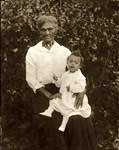 |
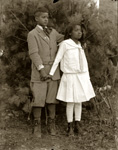 |
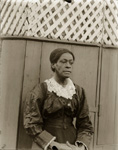 |
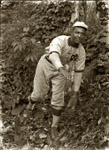 |
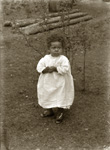 |
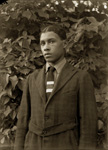 |
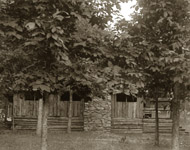 |
(All
image courtesy of Larry Black)
|
|